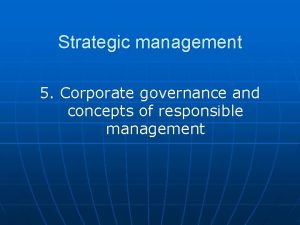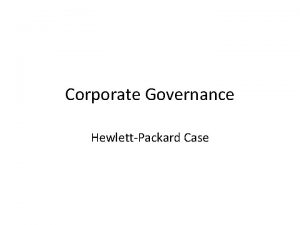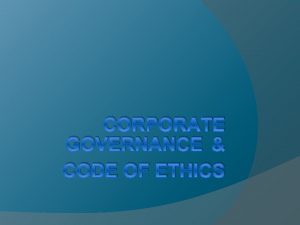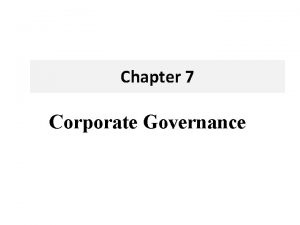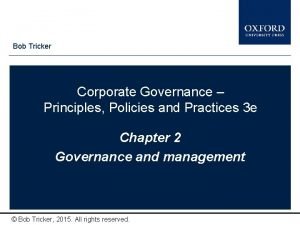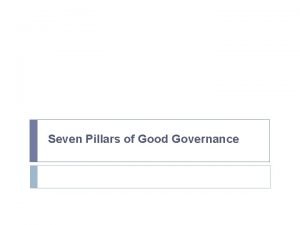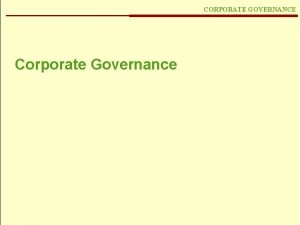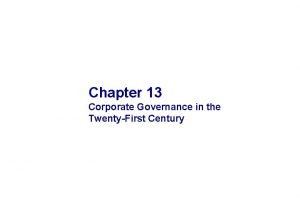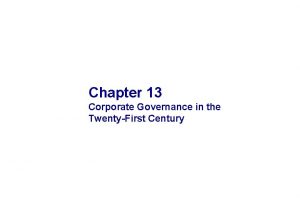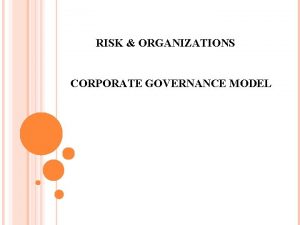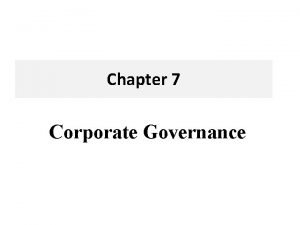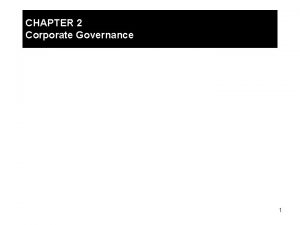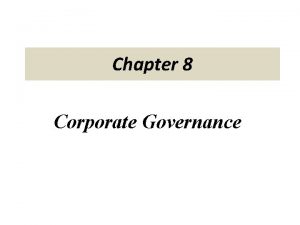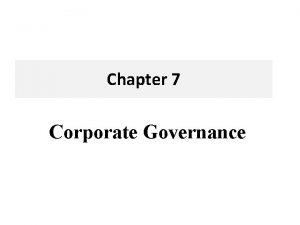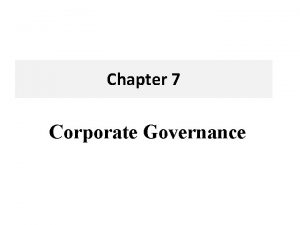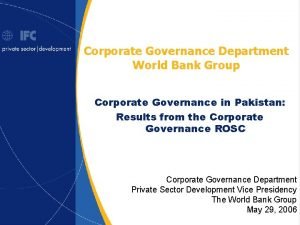Chapter 14 Corporate Governance in the TwentyFirst Century





















- Slides: 21

Chapter 14 Corporate Governance in the Twenty-First Century Copyright © 2012 Pearson Canada Inc. 0

LEARNING OBJECTIVES 1. Describe what corporate governance is and why it matters. 2. Explain the three alternative approaches to improving the governance of companies. 3. Compare and contrast corporate governance practices around the world. 4. Identify specific factors that affect the state of governance in Canada. 5. Show boards of directors are structured and explain the roles they play in corporate governance. 6. Design an executive incentive plan that will serve as a device for corporate governance. 7. Illustrate how the market for corporate control is related to corporate governance. Copyright © 2012 Pearson Canada Inc. 1

The Need for Governance • Management, when left unchecked, does not necessarily operate in ways that serve shareholders’ interests. • To address this problem, systems of policies and processes have been developed in companies that allow the board to direct and control management’s activities. • In principle, this should produce higher operating performance. Copyright © 2012 Pearson Canada Inc. 2

The Benefits of Good Governance • Good corporate governance leads to efficient allocation and management in the corporate sector capital. • The quality of governance will be reflected in the prices of public shares because public shareholders, whose entitlements to the company’s cash flows are the most fleeting, feel the pinch of poor governance first. • Inept or venal management usually erodes the share price first. • Other stakeholders are harmed only when the problems persist. Copyright © 2012 Pearson Canada Inc. 3

Alternative Approaches to Governance Improved governance of companies has been built on a combination of three approaches: 1. Codes of Conduct 2. Laws 3. Contracts Copyright © 2012 Pearson Canada Inc. 4

Alternative Approaches to Governance Codes of Conduct • The first approach includes the optional codes of conduct, which include best-practice principles and guidelines provided by industry and investor associations. • These codes create awareness of the need for and methods for creating stronger corporate governance. • The codes tend to be “principles based, ” providing companies with some discretion when deciding whether to comply with them or to explain deviations from them. Copyright © 2012 Pearson Canada Inc. 5

Alternative Approaches to Governance Laws • The second approach is corporate law, both statutory and judicial. • Legal mechanisms are necessary to protect shareholders’ rights and interests as the separation between investors and managers has increased with the growth of companies. • All countries except those that follow a communist economic system have laws that define private companies and the corporate governance mechanisms that these companies have to implement. • As legal mechanisms cannot specify ex ante what each party must do in every possible state of the world, they are inevitably incomplete. Copyright © 2012 Pearson Canada Inc. 6

Alternative Approaches to Governance Contracts • The third approach is comprised of contractual mechanisms. • Parties bargain for contractual terms that address possible dissension ex ante instead of relying on the legal system to address problems ex post, an exercise that is often costly, time consuming, and uncertain. • The search for contractual terms that improve the governance structure tends to involve bargaining over four elements: control, duration, risk of losses, and share of returns. Copyright © 2012 Pearson Canada Inc. 7

Corporate Governance Around the World • United States • Canada Survey Results for Canada Special Factors Influencing Governance in Canada Controlling Shareholders Dual-Class Shareholders Business Groups Institutional Investors • Germany • China Copyright © 2012 Pearson Canada Inc. 8

Role of Board of Directors THE DUAL CHAIRMAN OF THE BOARD/CEO • A common feature of North American boards is that the same individual serves both as the chairman of the board and as the chief executive officer of the company. • CEOs tend to like this arrangement. • The argument made for serving dual roles includes that specialized information is needed that an outsider does not have, that there is a lack of qualified candidates for one of the positions, and that splitting the roles creates tension because the chairman can overreach his/her boundaries and get involved in the day-to-day management of the company. Copyright © 2012 Pearson Canada Inc. 9

Role of Board of Directors INSIDE VERSUS OUTSIDE DIRECTORS • A distinction is made between directors who are employed by the company and those who are not. • Those employed by the company are called “inside” directors and typically come from the top management of the company. • Those who are not employed by the company are called “outside” directors. • From the perspective of good governance, a board consisting mostly of outside directors is preferred because they are seen as more independent in fulfilling their board responsibilities. Copyright © 2012 Pearson Canada Inc. 10

Role of Board of Directors DESIRED BACKGROUND OF THE DIRECTORS • Research shows that positive CEO–board interactions are maximized when the selection of outside board members matches the competitive environment facing the company. • Companies operating in relatively stable competitive environments get better advice from outside board members drawn from other companies that are strategically related to the company. • In these stable environments, the knowledge and experience that board members gain in their own company translates well to the company they monitor. Copyright © 2012 Pearson Canada Inc. 11

Role of Board of Directors COMPOSITION OF BOARD COMMITTEES • Boards are generally organized into several committees as each committee focuses on a key board responsibility. • The governance committee plays a major role in ensuring that the board meets its responsibilities. • It manages the dynamics of the board, setting committees’ terms of reference, the criteria for their leadership, and managing dysfunctional behaviour. Copyright © 2012 Pearson Canada Inc. 12

Role of Board of Directors MONITORING VERSUS ADVISING • In all cases, the general responsibility of the board is to ensure that executives are acting in shareholders’ best interests. • The board is legally charged with monitoring management, but it can also provide advice and counsel to the CEO and other top executives. • Monitoring is the process of the board acting on its legal and fiduciary responsibilities to oversee executive’s behaviour and performance and to take action when necessary to replace management. Copyright © 2012 Pearson Canada Inc. 13

Role of Board of Directors INTERLOCKING BOARDS • Directors who sit on multiple boards connect with other directors (a characteristic called a board interlock). • Debate continues as to whether such board interlocks help companies perform better by virtue of their access to better information or simply allow corporations to collude at the expense of the public at large. • Although there is no evidence that consumers are generally harmed by such interrelationships at the board level, strategy research has shown that directors themselves may be more effective as monitors if they are linked to certain companies given the competitive standing and environmental turbulence facing the focal companies. Copyright © 2012 Pearson Canada Inc. 14

Aligning Executives’ and Shareholders’ Interests EXECUTIVE STOCK OWNERSHIP Stock Ownership Policies Company-Related Risk EXECUTIVE INCENTIVE COMPENSATION Incentive Plans Bonus Plans Stock Option Plans Restricted Stock Copyright © 2012 Pearson Canada Inc. 15

Aligning Executives’ and Shareholders’ Interests - INCENTIVE COMPENSATION Annual bonus plans Oldest form of incentive pay. Board can evaluate executives’ performance along multiple dimensions and allocate a yearend cash award Stock options An employee receives the right to buy a set number of shares of company stock at a later date for a predetermined price Other long-term incentives More recent forms of incentive compensation. Long-term bonuses linked to performance over several years. May help executives avoid short-term myopia and focus on long-term Copyright © 2012 Pearson Canada Inc. 16

Aligning Executives’ and Shareholders’ Interests THE WELL-DESIGNED COMPENSATION PLAN • A manager’s total compensation consists of three components: salary, benefits, and incentive compensation. • Managers of larger companies typically receive more compensation than those in smaller companies. • In addition, compensation of companies in the same industry tends to be competitive. • Companies with low levels of compensation tend to have higher turnover. Copyright © 2012 Pearson Canada Inc. 17

An Agency Approach to Governance Agent Party, such as a manager, who acts on behalf of another party. Principal Party, such as a shareholder, who hires an agent to act on his or her behalf. Copyright © 2012 Pearson Canada Inc. 18

An Agency Approach to Governance • When interests are virtually Principals Shareholders of a firm identical, the agency problem is small: executives do what is in principals’ best interests Agents Act on behalf of principals in managing the firm • However, interests often do Copyright © 2012 Pearson Canada Inc. not overlap. Then agents may act to detriment of principals and visa-versa (e. g. , executives raise salaries and reduce returns) 19

The Market for Corporate Control • The market for corporate control reflects the view that every public company is for sale. • The market is the sum of all the possible buyers of corporate stock and the individual shareholders of the company (who might be “sellers” in this market). • The term control refers to what can be bought and sold in this market—the control of corporations. Copyright © 2012 Pearson Canada Inc. 20
 Objective of corporate finance
Objective of corporate finance Examples of agency problems
Examples of agency problems Agency theory examples
Agency theory examples Definitie corporate governance
Definitie corporate governance What is ownership
What is ownership Strategic control
Strategic control Isu dan riset kontemporer corporate governance
Isu dan riset kontemporer corporate governance Introduction of corporate governance
Introduction of corporate governance Ifc corporate governance
Ifc corporate governance Corporate governance in sri lanka
Corporate governance in sri lanka Cmda corporate governance code
Cmda corporate governance code Hp corporate governance
Hp corporate governance P&g code of conduct
P&g code of conduct Corporate governance definition
Corporate governance definition Corporate governance and social responsibility
Corporate governance and social responsibility Tricker
Tricker Corporate governance is which approach
Corporate governance is which approach Four pillars of good governance
Four pillars of good governance Corporate governance is a form of
Corporate governance is a form of Corporate governance tool kit
Corporate governance tool kit Corporate social responsibility and good governance
Corporate social responsibility and good governance Latar belakang munculnya gcg di indonesia
Latar belakang munculnya gcg di indonesia




